Environmental Humanities

English professor and Fulbright scholar Betsy Bolton shares digital stories with some of her collaborators: Hamid and Mohammed, traditional artisans in the Fès medina. Professor Bolton will be teaching ENVS 005. Changemakers in the fall of 2015 and co-teaching ENVS 001. Introduction to Environmental Studies in the spring of 2016.
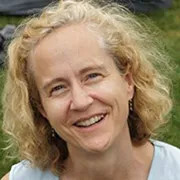
Betsy Bolton, Director, Environmental Studies.
People are often startled that an English professor is directing Environmental Studies, but our program has been interdisciplinary from the start: the humanities, social sciences, and natural sciences all contribute. Indeed, when it comes to shaping responses to environmental challenges, cultural concerns carry as much as or more influence than scientific knowledge. In grappling with the complexity of climate change or the diverse challenges posed by water issues, food justice and resilience, solid waste treatment, extreme fossil fuel extraction methods, and more, we all know better than we do. Closing the gap between what we know and what we do demands interdisciplinary engagement.
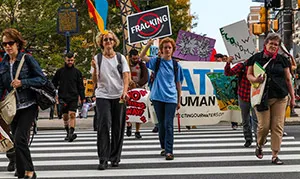
What do the humanities bring to the environmental studies table? In general, the arts and humanities specialize in questioning, challenging, and articulating human values, as well as imagining new possibilities. In a world of soaring atmospheric carbon and economic inequality, we urgently need to question social assumptions and imagine new ways forward. Combined with the natural sciences, the arts and humanities can highlight theoretical assumptions and blindspots; they can also make scientific findings more accessible to a wider range of people. Combined with social sciences (such as economics, political science, sociology and anthropology), the arts and humanities can invite broader engagement in questions of public policy and social change.
In the English department, I serve as a Romanticist, and the Romanticists were early environmentalists. William Wordsworth, for instance, was an early tree-hugger who managed to protect the heart of the Lake District from the rush to build train lines over every part of the landscape. The rhetoric of the natural sublime influenced the American Romanticists (notably Emerson and Thoreau), whose writings in turn influenced the Wilderness Act protecting national forests.
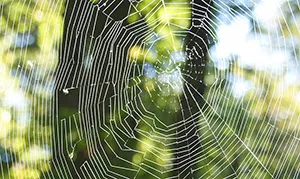
Crum Woods
Of course, as writers such as William Cronon and Michael Pollan point out, framing nature as “wilderness” has meant we don’t do a very good job of stewarding natural resources closer to home. Swarthmore has a woodland that runs beside the campus—the second largest green space left in Delaware county—and I’ve served on the Crum Woods Stewardship committee more or less since its inception. For years, I’ve taught an Environmental Studies course entitled “Writing Nature” in order to take students into these woods and help them experience what Barry Lopez calls the “long, fierce peace” that can derive from seeing how the various parts of the woodland community fit together. Over the years, I’ve asked students to use different media for engaging the woods: sketching slows us down enough to explore form and function; photography can highlight color, shape, line; audio recordings capture soundscapes; vernacular mapping whimsically explores spatial relations; digital storytelling brings different media together in narrative form. My teaching stresses community, working to connect the community of the woods and the community of the class.
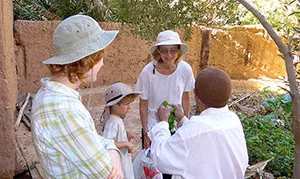
During a 2013-14 Fulbright year in Morocco, I explored (among other things) the 2,000-year-old permaculture systems of the oases or palmeries
A personal interest in food resilience and food justice has also led me to pursue training in permaculture, a design approach to sustainability that draws on ecological systems and indigenous knowledge. Permaculture design principles include among other things a focus on observation and interaction, a commitment to capture and store energy, to use edges and value the marginal, to produce no waste, to use and respond creatively to change. I completed a Permaculture Design Course in May 2013.
During a 2013-14 Fulbright year in Morocco, I explored (among other things) the 2,000-year-old permaculture systems of the oases or palmeries. I also saw first hand the challenges faced by subSaharan migrants through Morocco: many are environmental refugees. For more about this Fulbright project, see maghrebi-voices.swarthmore.edu.
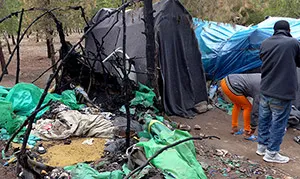
Migrants. Visit maghrebi-voices.swarthmore.edu
This past year, I started work on a 4.4 acre regenerative agroforestry project in Wallingford (about 4 miles from campus) with summer help from Environmental Studies minor Olivia Ortiz; I’m blogging about “the cliff” at wildestpantry.wordpress.org. In August 2015, I completed a course in Permaculture Teacher Training for Women with my Scripps College collaborator, Nancy Neiman Auerbach. Nancy and I are exploring ways to connect our bi-coastal communities and food work; meanwhile, closer to home, Giovanna di Chiro, Yvonne Chireau, Syd Carpenter, and Alison Dorsey are some of the women whose work with food issues I admire.
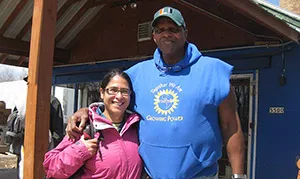
Nancy Neiman Auerbach with Will Allen of Growing Power
I’m very excited about a new course I’m teaching in the fall of 2015, called “Changemakers,” the seed of which was planted during the College’s Sustainability Charrette in February 2015. The course aims to do two things: 1) create materials toward a digital user’s guide to campus, mapping some of the flows of energy, water, food, materials, and people across the campus; and 2) practice creating change by crafting a detailed sustainability proposal and working to generate campus support for that proposal. Creating the course has been a collaborative effort, with contributions from Vice-President of Finance Greg Brown, departing Director of Sustainability Laura Cacho, Sustainability Coordinator Melissa Tier, students Adina Spertus-Melhus and Anna Gonzales, Sustainability Committee members Ralph Thayer, Eric Wagner, Carr Everbach, staff of the Lang Center for Civic and Social Responsibility, and others.



